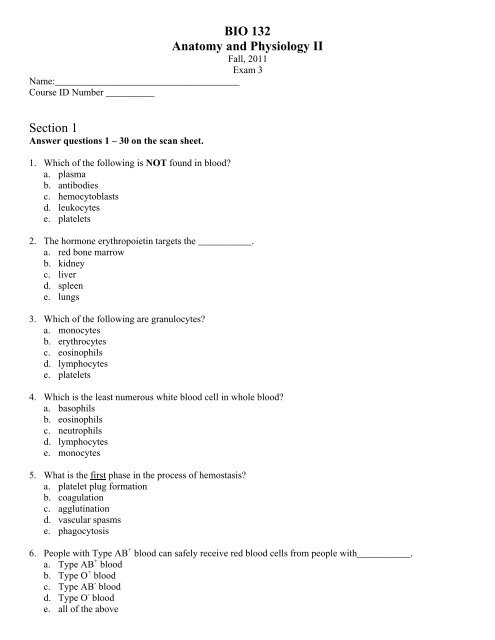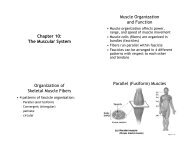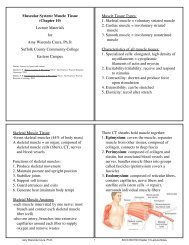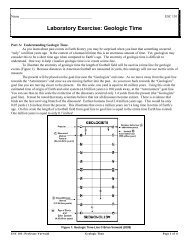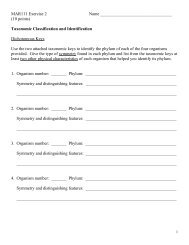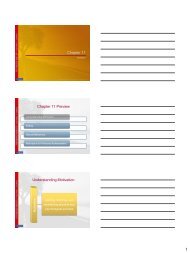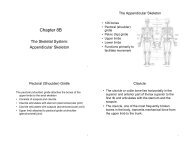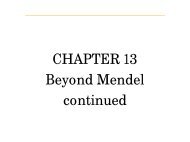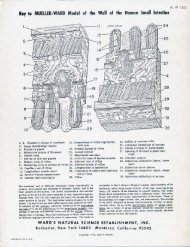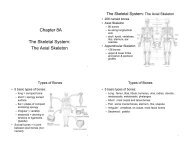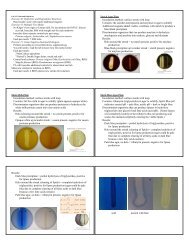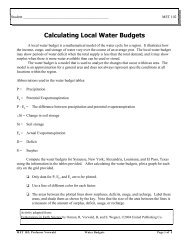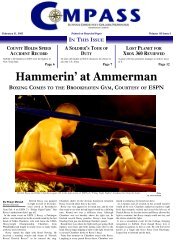Create successful ePaper yourself
Turn your PDF publications into a flip-book with our unique Google optimized e-Paper software.
BIO 132<br />
Anatomy and Physiology II<br />
Fall, 2011<br />
<strong>Exam</strong> 3<br />
Name:______________________________________<br />
Course ID Number __________<br />
Section 1<br />
Answer questions 1 – 30 on the scan sheet.<br />
1. Which of the following is NOT found in blood?<br />
a. plasma<br />
b. antibodies<br />
c. hemocytoblasts<br />
d. leukocytes<br />
e. platelets<br />
2. The hormone erythropoietin targets the ___________.<br />
a. red bone marrow<br />
b. kidney<br />
c. liver<br />
d. spleen<br />
e. lungs<br />
3. Which of the following are granulocytes?<br />
a. monocytes<br />
b. erythrocytes<br />
c. eosinophils<br />
d. lymphocytes<br />
e. platelets<br />
4. Which is the least numerous white blood cell in whole blood?<br />
a. basophils<br />
b. eosinophils<br />
c. neutrophils<br />
d. lymphocytes<br />
e. monocytes<br />
5. What is the first phase in the process of hemostasis?<br />
a. platelet plug formation<br />
b. coagulation<br />
c. agglutination<br />
d. vascular spasms<br />
e. phagocytosis<br />
6. People with Type AB + blood can safely receive red blood cells from people with___________.<br />
a. Type AB + blood<br />
b. Type O + blood<br />
c. Type AB - blood<br />
d. Type O - blood<br />
e. all of the above
7. Which of the following statements is correct regarding the cardiovascular system?<br />
a. The wall of the right ventricle is thicker than the wall of the left ventricle.<br />
b. The blood in the vena cava is oxygen rich blood.<br />
c. Only the atrioventricular valves allow a bi-directional (2 different directions) flow of blood.<br />
d. The heart contains four chambers.<br />
e. None of the above.<br />
8. The ___________ is the outer (most superficial) layer of the heart.<br />
a. endocardium<br />
b. medulla<br />
c. cortex<br />
d. myocardium<br />
e. epicardium<br />
9. The ____________ is the chamber of the heart connected to the pulmonary veins.<br />
a. right atrium<br />
b. right ventricle<br />
c. left atrium<br />
d. left ventricle<br />
10. Chordae tendineae are attached to ____________ and ____________.<br />
a. AV cusps; Purkinjie fibers<br />
b. Bundle branches; AV node<br />
c. Papillary muscles; AV cusps<br />
d. Semilunar valves; papillary muscles<br />
e. Purkinjie fibers; papillary muscles<br />
11. Which of the following is closest to the apex of the heart?<br />
a. the atria<br />
b. the papillary muscles<br />
c. the aortic semilunar valve<br />
d. the sinoatrial node<br />
e. the tricuspid valve<br />
12. Regarding Ca 2+ (calcium) in the process of excitation-contraction coupling of cardiac myocytes, which of<br />
the following statements is FALSE?<br />
a. Calcium enters from the extracellular fluid during the plateau phase of the action potential.<br />
b. An increase in the amount of Ca 2+ that enters the sarcoplasm during excitation, will decrease the<br />
strength of contraction of a cardiac myocyte.<br />
c. Ca 2+ is released from the sarcoplasmic reticulum due to entry of Ca 2+ from the extracellular fluid.<br />
d. Ca 2+ ultimately allows the binding of actin to myosin for cross-bridge cycling to occur.<br />
e. In a cardiac myocyte that is in diastole, the intracellular Ca 2+ concentration is low.<br />
13. Which of the following aspects of the electrocardiogram occurs during atrial repolarization?<br />
a. P wave<br />
b. QRS complex<br />
c. P-Q segment (time between the P wave and QRS complex)<br />
d. T wave<br />
e. Q-T segment (time between the QRS complex and the T wave)
14. The amount of blood that is pumped out of a ventricle every minute is defined as the __________.<br />
a. heart rate<br />
b. blood pressure<br />
c. stroke volume<br />
d. cardiac output<br />
e. systole<br />
15. Contraction of the right ventricle moves blood through the ____________.<br />
a. pulmonary semilunar valve<br />
b. mitral valve<br />
c. tricuspid valve<br />
d. aortic semilunar valve<br />
e. bicuspid valve<br />
16. The volume of blood that fills the ventricles before they contract is called the ____________.<br />
a. hematocrit<br />
b. stroke volume<br />
c. end diastolic volume<br />
d. cardiac output<br />
e. residual volume<br />
17. A high frequency of action potentials generated by the sinoatrial node results in ____________.<br />
a. fibrillation<br />
b. tachycardia<br />
c. hypotension<br />
d. bradycardia<br />
e. depolarization<br />
18. Which of the following is NOT a property or a function of the sinoatrial node?<br />
a. It conducts impulses within the heart.<br />
b. It increases its action potential frequency in response to norepinephrine exposure.<br />
c. It spreads the action potential into the atria.<br />
d. It contracts to pump blood into the ventricles.<br />
e. It provides the heart with an autorhythmic property.<br />
19. During the cardiac cycle, the semilunar valves of the heart are closed:<br />
a. when the atria are in systole.<br />
b. when the ventricles are ejecting blood.<br />
c. during the time between the QRS complex and the T wave of the ECG.<br />
d. to prevent the movement of blood from the ventricles into the atria.<br />
20. Which of the following vessels connected to the heart contains oxygen poor blood?<br />
a. the pulmonary vein<br />
b. the pulmonary trunk<br />
c. the aorta<br />
d. the carotid artery<br />
e. none of the above
21. Another name for the left atrioventricular valve is the_________.<br />
a. tricuspid valve<br />
b. bicuspid valve<br />
c. pulmonary semilunar valve<br />
d. aortic semilunar valve<br />
e. none of the above<br />
22. ____________ are proteins that connect the cytoplasm of 2 adjacent cardiac myocytes.<br />
a. Purkinjie fibers<br />
b. Thin filaments<br />
c. Thick filaments<br />
d. Sarcomeres<br />
e. Gap junctions<br />
23. Which of the following occurs as a result of an increase in the contractility of cardiac myocytes?<br />
a. a decrease in stroke volume<br />
b. a decrease in blood pressure<br />
c. an increase in cardiac output<br />
d. an increase in heart rate<br />
e. a decrease in blood flow<br />
24. The innermost layer of all blood vessels is called the ____________.<br />
a. tunica media<br />
b. tunica mucosa<br />
c. tunica externa<br />
d. tunica interna<br />
e. tunica sandwich<br />
25. Most (~60%) of the body’s blood volume can be found in the ____________.<br />
a. arteries<br />
b. capillaries<br />
c. veins<br />
d. right atrium and right ventricle<br />
e. left atrium and left ventricle<br />
26. You measure the blood pressure of an individual as being 105 /75. The “75” refers to the ____________.<br />
a. stroke volume<br />
b. ventricular diastolic pressure<br />
c. venous blood pressure<br />
d. heart rate<br />
e. atrial systolic pressure<br />
27. _________________ is determined by the diameter of blood vessels.<br />
a. Blood viscosity<br />
b. Peripheral vascular resistance<br />
c. Blood vessel length<br />
d. Plasma volume<br />
e. Hematocrit
28. Which of the following will cause a decrease in blood flow? Remember: Flow = Pressure /Resistance<br />
a. a decrease in blood viscosity<br />
b. an increase in heart rate<br />
c. an increase in the blood volume<br />
d. an increase in stroke volume<br />
e. vasoconstriction<br />
29. In which of the following blood vessels is systemic blood pressure the lowest?<br />
a. artery<br />
b. vein<br />
c. arteriole<br />
d. venule<br />
e. capillary<br />
30. An increase in the blood pressure sensed within the aorta will cause a(n):<br />
a. increase in the vasoconstriction of systemic arteries.<br />
b. increase in stroke volume.<br />
c. secretion epinephrine from the adrenal glands.<br />
d. decrease in heart rate.<br />
e. all of the above.<br />
Section 2<br />
Answer questions 31 – 35 on the scan sheet using A = increase, B = not change, or C = decrease<br />
The cause is described before the blank and the effect is described after the blank in all questions.<br />
31. Cholinergic stimulation will ______________ the blood pressure.<br />
32. An increase in the heart rate will _____________ cardiac output.<br />
33. An increase in the preload on the heart will __________ the stroke volume.<br />
34. Bradycardia will _______________ blood flow.<br />
35. An increase in the hematocrit will _______________ blood flow through a vein.


